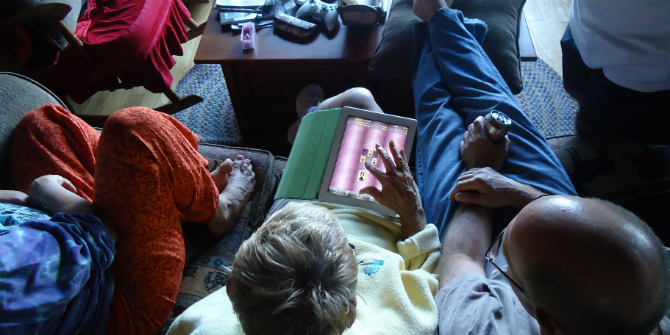 Children who are vulnerable offline are more likely to encounter multiple risks online – but current advice on safety fails to take into account their differing levels of resilience. In this post, Adrienne Katz and Dr Aiman El Asam outline the findings from a major UK study into the links between online and offline vulnerability and recommend changes for practitioners on how to improve online safety education. Adrienne Katz is the director of Youthworks Consulting and Dr Aiman El Asam is a lecturer in Forensic Psychology at the Department of Psychology, Kingston University.
Children who are vulnerable offline are more likely to encounter multiple risks online – but current advice on safety fails to take into account their differing levels of resilience. In this post, Adrienne Katz and Dr Aiman El Asam outline the findings from a major UK study into the links between online and offline vulnerability and recommend changes for practitioners on how to improve online safety education. Adrienne Katz is the director of Youthworks Consulting and Dr Aiman El Asam is a lecturer in Forensic Psychology at the Department of Psychology, Kingston University.
With an increasing focus on vulnerable children, is this the time to think about their digital lives? Our recent study found that young people who are vulnerable offline, were at far greater risk online than their peers and in multiple, connected ways. At the same time, the challenges of delivering relevant online safety education to all children and young people became abundantly clear.
“They tell you OVER and OVER again how to stay safe online and they say it so much you don’t want to remember it,” said one young person in the Cybersurvey 2014 (Suffolk)
Imagine an online safety session for a year-nine class. The speaker may be excellent and knowledgeable but often has little idea of what the class already knows; who is a slow learner or which student has emotional difficulties. The teenagers receive the standard advice: stories about the dangers online and information on how to protect themselves, with some rules. Some will absorb and act on it – but many won’t. Some can’t. There will be eye-rolling – they have heard it all before. Our study indicated only 28% of 14- to 15-year-olds say their online safety education was very good and they always follow the e-safety guidelines they were taught. They explain: “Some things are a bit over the top,” or, “The Internet is fun without rules.” Others have difficulty understanding or remembering it: “I forget about e-safety,” explained one respondent, or: “Because my friends don’t”.
But there are other reasons why an online safety session might not have the desired impact. In that class there might be three pupils with diagnosable mental health issues, one who is anorexic, two with parent problems or disruption at home and one with moderate learning difficulties. Two might be carers who have been missing school due to worries about someone at home. Several may not have English as a first language. Their needs vary and so do their online lives.
On top of this, a lot of advice about online safety is directed at parents to deliver to their children. But not all parents are in a position to do that. Vulnerable children need more than this.
Being vulnerable offline leads to high-risk situations online
Our study, Vulnerable Young People and Their Online Risks, explored the digital lives of 2,988 young people aged 10-16 in the UK. The original data was collected via the annual Cybersurvey. For the purposes of the study, respondents were grouped into five vulnerable groups:
- Family (children in care and young carers)
- Physical disability (including long-standing illness)
- Special educational needs
- Communication (hearing loss, speech difficulties, EAL)
- A self-reported mental health difficulty.
A control group was formed of those with no vulnerabilities.
Who is vulnerable?
Vulnerability, although implicitly understood, is defined by Munro as ‘susceptibility to physical or emotional injury’. The Department of Health describes vulnerability as being influenced not only by the child’s developmental needs, but by their parents’ capacity to meet these and other wider family and environmental factors. The Children’s Commissioner has identified 32 groups of vulnerable children in nine categories and points out that some remain hidden. None of them identify online vulnerabilities.
What are the online risks?
The 18 online risks and seven reasons for sexting were sorted into four categories: Contact, Conduct, Content and Cyberscams. ‘Contact’ explores sexting and the reasons respondents gave for doing so. ‘Content’ explored harmful content, pro-anorexia, self-harm or suicide and extremist views and race hatred. ‘Cyberscams’ include being tricked into buying goods, buying fake or illegal goods, and having credit or personal details hacked.
Each risk category showed a relationship to a particular vulnerabilities and the likelihood of experiencing certain other online risks was greater once a young person had encountered one. This can lead to a cascade of risk for someone who is already very vulnerable offline.
What did we learn?
Multiple linear regression analysis showed that being vulnerable offline significantly contributes to being at greater risk in the digital world. Not only could vulnerability predict a basket of high-risk online situations, but there were patterns between each vulnerability and the categories of risk. This raises questions for interventions, training for services and education for vulnerable young people.
The study underlined how important it is to think about a young person’s online life generally. The young person may report one issue, but their wider experiences are also relevant. For example if a young person has been a victim of a cyberscam and are experiencing a contact risk, such as being coerced into sharing an explicit image, and they have been cyberbullied, this person is significantly more likely to be visiting sites with harmful content (pro-anorexia sites, self-harm or suicide encouraging sites). This could exacerbate existing vulnerabilities. Kardefelt-Winter for UNICEF points out that, ‘It is not feasible to investigate the effects of digital technology in isolation from children’s lives in a broader sense.’
While the majority of young people develop enough problem-solving skills and resilience to be able to enjoy what technology can offer, this is often not the case for our vulnerable young people. Online harm may affect them more acutely because of their emotional difficulties or life experiences and the fact that, as we learned, they are likely to face more than one high-risk situation.
These children and young people come into contact with many different practitioners and professionals. At present, referrals do not often take into account the client’s online life, and there is a lack of specialist training for services to be able to respond to clients’ or patients’ complex needs as they relate to their online problems.
For families, practitioners and frontline professionals, knowledge of these patterns could help to deliver better interventions, more appropriate advice and genuine help to a distressed young person. Care workers would often say that they helped a young person reduce their ‘friends’ list of 200 unknown people, only for the problem to recur. Without addressing the reasons why this vulnerable teenager feels they need these unknown ‘friends’, problems could continue and escalate.
Time to modernise our thinking?
Researchers increasingly question the current model of online safety education. It is often reduced to warnings and rules, overlooking the excitement, benefits and sheer fun of technology. Motivation for our actions and learning about relationships are rarely part of online safety lessons. Teaching media literacy is a viable aim, but the argument that this in itself is enough to reduce the potential for harm is not proven. The emotional need for intimacy, affirmation or simply to connect, will often override any advice teenagers may have been given. To help them stay safe and to respond when things go wrong, we need to acknowledge their emotional needs and offline vulnerabilities and build online safety into wellbeing, mental health in schools, relationships and sex education and safeguarding.
Online safety education has become too isolated as a subject, and easy to miss if a young person is often absent or frequently moving to a new school due to care placements. In a recent survey of secondary school staff, 27% said they delivered an online safety session only once a year.
The focus of interventions should broaden beyond the issue the child reports, taking into account known vulnerability offline and the likely potential online risks. A wider approach to interventions has been suggested before: Wolak, Finkelhor, Mitchell and Ybarra point out that in relation to protecting young people from online predators, attention should be paid to young people at higher risk, including those with histories of sexual abuse, sexual orientation concerns, and patterns of off- and online risk taking. Two years later Stamoulis and Farley confirmed that the ‘four or more risks’ rule proposed by Wolak et al, was also supported by their work. In this approach if four or more risk factors are present the case is escalated.
The Association for Young People’s Health also argues that, “Improved resilience will not result from any one particular action or decision; it arises from a ‘critical mass’ of different efforts to improve young people’s outcomes. A whole system approach is necessary to ensure that commissioners … are working to meet the overall needs of local young people, rather than providing services in a piecemeal fashion.”
‘Keeping Children Safe in Education’ 2018 views online safety not as an add-on or afterthought, but as fully integrated into safeguarding. We agree but would go further:
- Online safety education advice and support for vulnerable young people needs to consider the whole person and, as advocated by the Contextual Safeguarding Network, their life beyond the home.
- Offline vulnerabilities, age, gender and mental and emotional health difficulties should all be considered as part of a whole picture if a young person reports they have a problem online.
- There should be more specialist training for practitioners and frontline professionals to be able to better respond to clients’ or patients’ complex needs both online and offline.
- The emotional needs and motivations of children should be considered, and online safety should be included in wellbeing, mental health, relationships and sex education in schools.
Notes
Aiman El Asam and Adrienne Katz (2018). Vulnerable Young People and Their Online Risks. Journal: Human-Computer Interaction 2018. Summary. Presentation.
About the Cybersurvey and annual reports.
This post gives the views of the authors and does not represent the position of the LSE Parenting for a Digital Future blog, nor of the London School of Economics and Political Science.





